Northern Explorer: 7 Day Rail Itinerary of Tohoku and Hokkaido
Most visitors who arrive in Tokyo use their Japan Rail Pass to head southwest towards Kyoto instead of heading north to the region of Tohoku and the island of Hokkaido. While Kyoto is always a worthy stop on any itinerary, the north offers many unique experiences – most without the crush of tourists at sites in and around the former Imperial capital.
Itinerary Outline
This itinerary takes you from Tokyo through the mountainous hinterland of Fukushima, up to the shores of the Sanriku sub-region and onwards to Honshu’s northernmost prefecture. From there, it’s a jaunt through the world’s longest undersea tunnel to the historic port of Hakodate in southern Hokkaido.
Itinerary Quick Links
Day One: Tokyo to Aizuwakamatsu
Day Two: More Aizuwakamatsu, then on to Sendai
Day Three: Oku Nikkawa and the Matsushima coastline
Day Four: Sendai to Hirosaki
Day Five: Shirakami Sanchi
Day Six: Hirosaki to Hakodate
Day Seven: Hakodate to Tokyo
Day One: Tokyo to Aizuwakamatsu
Travel time: Approximately 3 to 3 1⁄2 hours, including waiting
Route: Tokyo Station to Koriyama Station via Shinkansen (1 hour 20 minutes)
Change to JR Banetsu West Line for Aizuwakamatsu (1 hour 20 minutes)
Regular cost: 9,480 yen
Objective: Enjoy some wild history and nature
Aizuwakamatsu is the largest city in the Aizu region of Fukushima Prefecture. Let’s get the Fukushima thing out of the way first. The area around the Fukushima Daiichi disaster site is still a no-go, but what most outsiders don’t realize is that Fukushima Prefecture is very, very big. The distance from the inland city of Aizuwakamatsu to the power plant site is 120km.
The Aizu region is a rugged, mountainous area famed for being the base of the Aizu clan, as well as for the beauty of Lake Inawashiro.
If you catch an early train from Tokyo (the Shinkansen starts running just after 6am), you’ll have a full day to explore Aizuwakamatsu. Here are a few ideas for where to go and what to do.
To begin with, we recommend dropping off your luggage at the hotel. You probably won’t be able to check in before 1pm at the very earliest (it’s usually closer to 3pm in Japan), but it’s generally possible to leave your bags at the front desk. Whenever you move to a new area on this trip, try to do this, or otherwise leave your bags at a station luggage room or in a station locker. This will make your sightseeing much easier.
Aizuwakamatsu Washington Hotel is just a few hundred meters from the station, making it a convenient spot to stay the night. It’s nothing fancy, but it consistently gets good reviews from travelers. There is also Route Inn Aizuwakamatsu, which is close to the station too, and provides a free breakfast.
 Tsuruga Castle. Pic by yisris licensed under CC.
Tsuruga Castle. Pic by yisris licensed under CC.
Once you’ve stowed your bags somewhere safe, seek out the bus terminal at Aizuwakamatsu Station and get ready for some samurai-themed sightseeing. Aizuwakamatsu is known for its long history of warriors, and our first stop is the legendary Tsuruga Castle – one of the final strongholds of samurai who were loyal to the Tokugawa shogunate towards the end of Japan’s feudal era.
The castle is a 20-minute ride on the Aizu Loop Bus, and makes an excellent starting point for the day’s explorations. Once you’ve had a look around the building itself, tuck into a local-style lunch at the on-site restaurant called Ninomaru. You could then spend a good hour in the surrounding park, enjoying the greenery while walking off your meal. Stop for a cup of green tea at the historical Rinkaku Teahouse on your way out.
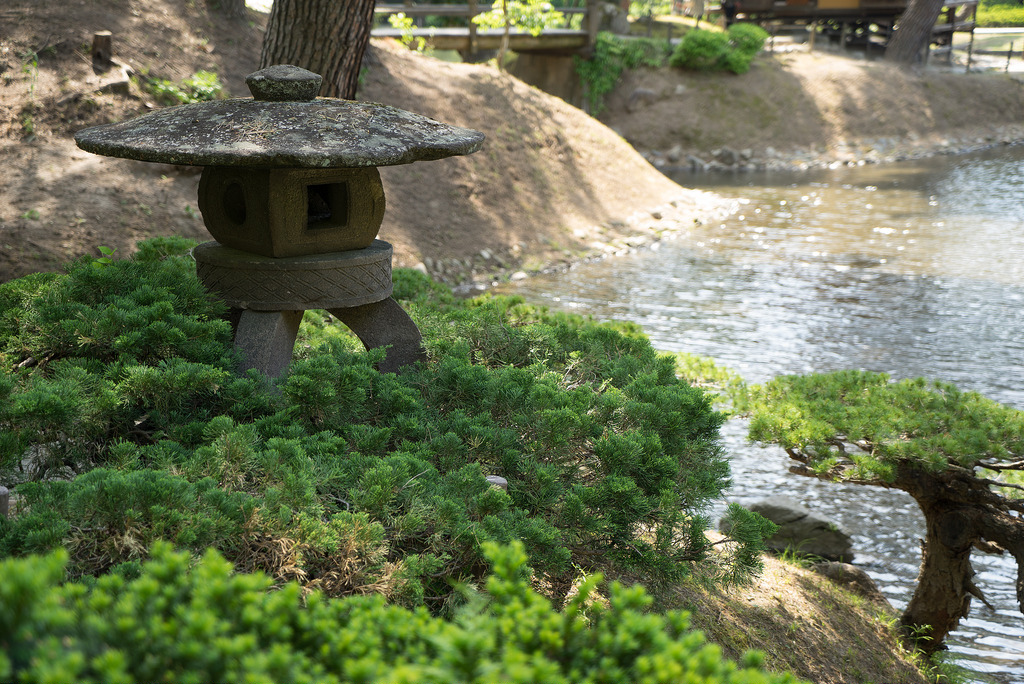 Oyakuen Garden. Pic by Dime Gontar licensed under CC.
Oyakuen Garden. Pic by Dime Gontar licensed under CC.
From there, it’s a short walk to the Fukushima Prefectural Museum, where you can gain a more in-depth understanding of the development of both the prefecture and country as a whole. The day can be rounded off by popping into the Aizu Sake Museum, where you can sample some of the region’s renowned brews. If you still have energy, consider going to see Oyakuen, a traditional Japanese garden that’s a few minutes away. Oyakuen, also known as Aizu Matsudaira’s Royal Garden, is home to an impressive array of medicinal herbs.
If you’re more into nature sightseeing, you can forego the castle and other in-town attractions and head instead for Lake Inawashiro. To get there, take the JR Banetsu West Line for Koriyama and get off at Inawashiro Station. It’s a 30-minute ride, followed by 15 minutes on a bus. The vast lake is said to be the fourth-largest in Japan, and can be explored by walking around parts of the shore, or taking a sightseeing boat out to the middle.
 Lake Inawashiro. Pic by cotaro70s licensed under CC.
Lake Inawashiro. Pic by cotaro70s licensed under CC.
Whatever you do with your day, on your way back to the hotel, pick a dinner spot from the eateries around the station – you’ll find sushi, ramen and other Japanese specialties, as well as some Western options. Aizu is known for its soba noodles and pork cutlets, so try those if you didn’t at lunchtime.
Day Two: More Aizuwakamatsu, then on to Sendai
There’s lots to see in and around Aizuwakamatsu, and we’re not in any hurry, so plan to look around most of the day before moving on to Sendai later in the afternoon.
Travel time: Approximately 2 1⁄2 hours, including waiting
Route: JR Banetsu Line from Aizuwakamatsu back to Koriyama Station (1 hour 4 minutes)
Change to the Shinkansen bound for Sendai (40 minutes)
Regular cost: 6,660 yen
Objective: Get closer to the samurai and soak in hot springs
Our first stop is Mount Iimori, which you can get to easily by heading counter-clockwise on the same bus route you used yesterday. Iimoriyama, as it’s known in Japanese, is chock-full of history, some of it quite tragic. It was here that 20 young boys, sons of Aizu samurai dedicated to stemming the tide of the invading pro-imperial forces, committed ritual suicide when they believed that Tsuruga Castle had been taken.
Apart from the memorial site and museum, you can also see an unusual piece of architecture – Sazaedo. This rare old temple, completed in 1796, is a three-storey pagoda with hexagonal floors and a double helix staircase, and climbing to the top is said to bring good fortune.
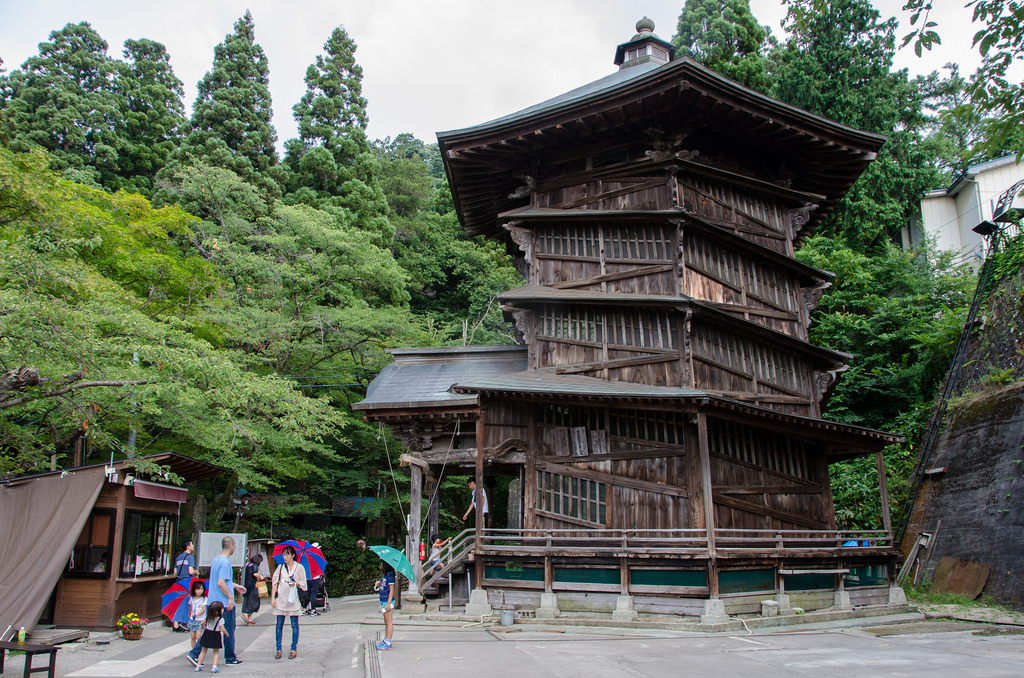 Sazaedo. Pic by cotaro70s licensed under CC.
Sazaedo. Pic by cotaro70s licensed under CC.
Next, it’s back onto the bus and off to an old samurai residence, the Aizu Bukeyashiki. Here, you can see how the samurai went about their daily lives, as well as explore an old tea house, rice mill and bailiff’s office. If you’re ready for lunch, the restaurant on the premises serves a decent meal. Alternatively, you can grab a bite to eat at Higashiyama Onsen, the hot spring town where we’re headed.
You can catch the bus or walk (it takes about 15 minutes) to the onsen village, which is built along the banks of the Yugawa River. It’s said to have been a favorite among writers and artists for centuries, soothing weary minds and bodies. Many of the hot springs are attached to hotels, but welcome daytrippers – you can simply walk around and see which ones are open when you are there. Harataki, which features a lovely big outdoor bath, is always a good choice.
When you’ve had a good soak, catch the bus back to Aizuwakamatsu Station and make your way to Sendai in Miyagi Prefecture. When you get there, you might want to check in to Hotel Vista Sendai if you’re on a budget, or something like Hotel Richmond Premier if you have a bit of money to spare. This will be your base for the next two nights. Both of these resthouses are a stone’s throw from Sendai Station. Dinner can be had at any of the myriad eateries in the station area.
Day Three: Oku Nikkawa and the Matsushima Coastline
No long-distance travel is planned for today. Instead, we’re heading to the lush nature of Oku Nikkawa Gorge, and then exploring the famous Matsushima coastline.
Travel time: Approximately 45 minutes to Okunikkawa, and then 1 hour 10 minutes from there to Matsushima-Kaigan Station
Route: JR Senzan Line from JR Sendai to Okunikkawa Station and back, then the JR Tohoku Line to Matsushima-Kaigan
Regular cost: 1,980 yen (round trip)
Objective: Relax and experience the beauty of Tohoku
Strap on your hiking boots and get ready to explore a place that you won’t find in many of the guidebooks. Oku Nikkawa is a breath of fresh air for travelers tired of the same-old tourist attractions; it’s a beautiful mountainous area dotted with waterfalls and crimson bridges. From Okunikkawa Station, follow the signs to one of two trails: the 3.6km Oku Nikkawa Line (which takes about two hours to complete), or the 5.4km Nikkawa Line (which requires around three and a half hours). You’ll want to dress warmly, as the area can be quite cool, even in summer. From mid-October, Oku Nikkawa Gorge bursts into a palette of fiery fall colours, making for some truly spectacular photos.
Our recommendation is to spend the morning at Oku Nikkawa, leaving you the afternoon to explore Matsushima. The bay is known as one of Japan’s three most scenic views (the other two being Miyajima and Amanohashidate), and when you get to Matsushima-Kaigan Station, you’ll quickly see why. Matsushima’s waters are dotted with approximately 260 pine-topped islets, making for a unique coastal scene. These tiny islands largely protected Matsushima from damage during the 2011 Tohoku earthquake and tsunami, though the disaster did alter the appearance of a few.
 Matsushima Bay. Pic by kazuletokyoite licensed under CC.
Matsushima Bay. Pic by kazuletokyoite licensed under CC.
Before we get to the islands, we’ll be popping into Zuiganji – a key Zen temple in the Tohoku region. This fine example of 17th-century Japanese architecture faces the bay, and has been designated a national treasure. The Art Museum on the premises is also worth a look. When you’re ready to move on, we’re nipping up to Shin-Tomiyama, which can be found along a back road between the temple and train station. This is one of the four panoramic views of Matsushima Bay – so have your camera ready.
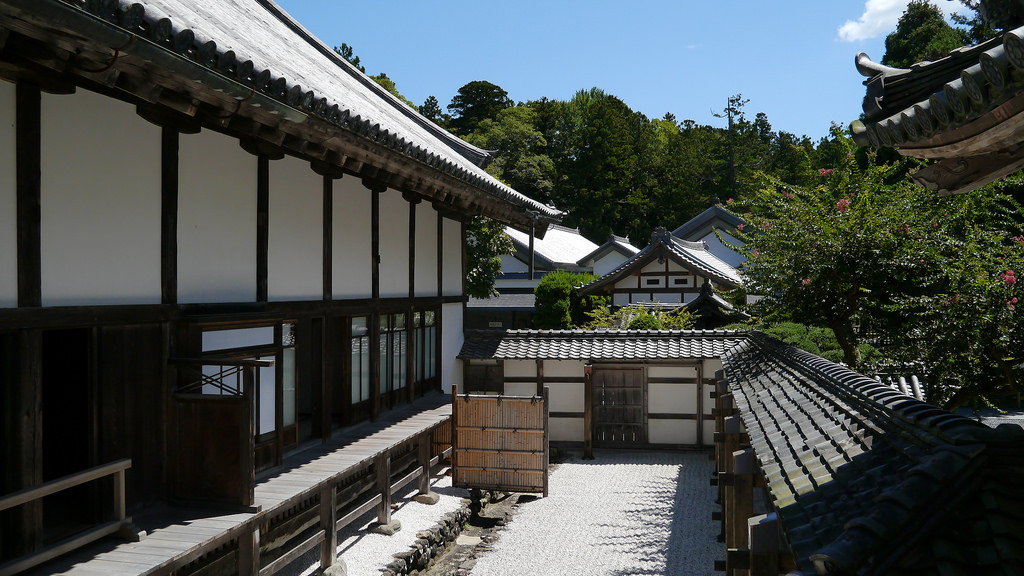 Zuiganji. Pic by Urushihara licensed under CC.
Zuiganji. Pic by Urushihara licensed under CC.
When your stomach rumbles, the Matsushima Fish Market is a good place for a meal (especially if you like the area’s speciality – oysters), and can be found near the Date Masamune Historical Museum (worth a quick visit). Alternatively, you can try a little restaurant called Shikitei near the station for fresh seafood and other local dishes.
From there, it’s on to see the islands themselves. You can get up close by boat (cruises depart frequently from Matsushima Pier), or get across to and around either Oshima or Fukuura Island (or both) by foot. Oshima is a small island close to the pier, which can be accessed via a short bridge. You can enjoy a stroll and see caves where monks used to go to meditate. Fukuura is accessible via a 252-meter long red bridge (believed to be a place of serendipitous encounters), and offers slightly longer walks – and lots and lots of plants. It takes about one hour to complete a circuit of this island.
 Bridge to Fukuura. Pic by Ivan Mlinaric licensed under CC.
Bridge to Fukuura. Pic by Ivan Mlinaric licensed under CC.
When you’ve had your fill of Matsushima, make your way back to Sendai for dinner and a good rest before the next day of travel.
Day Four: Sendai to Hirosaki
Travel time: Approximately 2 hours 10 minutes, including waiting
Route: Tohoku Shinkansen from Sendai to Shin-Aomori Station (1 hour 27 minutes)
Change to the Ou Main Line bound for Hirosaki (30 to 40 minutes)
Regular cost: 11,630 yen
Objective: See the historic town of Hirosaki
Today, we’re heading up north to Hirosaki, a city in Aomori Prefecture that’s known for its castle, floats, and cherry blossoms – among many other things. It’s one of the most culturally-rich parts of Japan, and yet an area that remains, strangely, off the most well-trodden tourist paths.
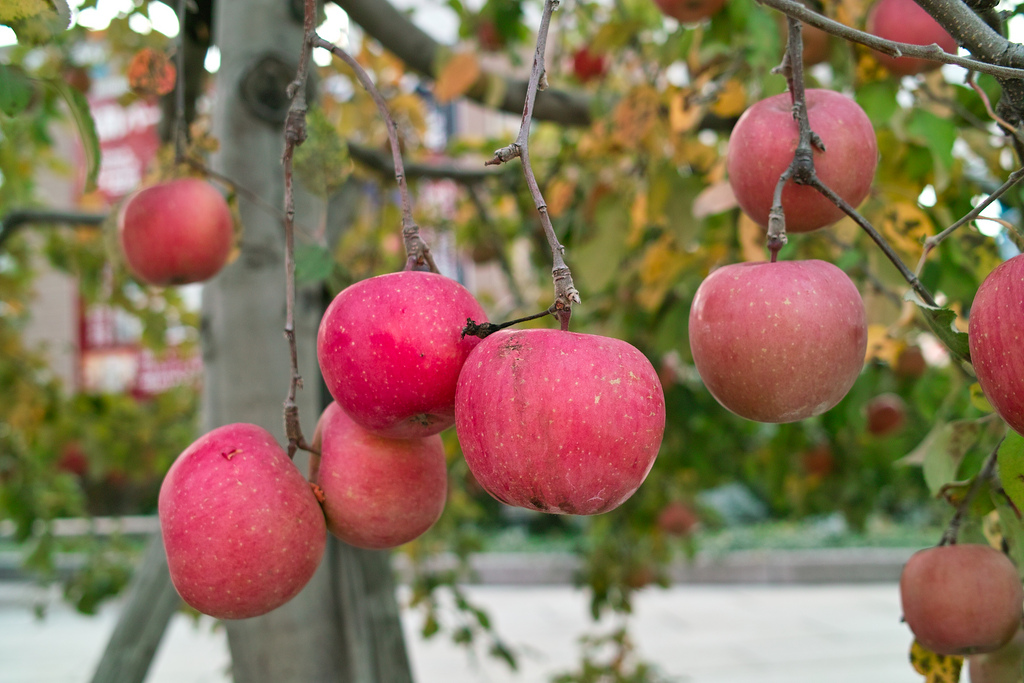 Hirosaki Apples. Pic by t-mizo licensed under CC.
Hirosaki Apples. Pic by t-mizo licensed under CC.
To make the most of your day in Hirosaki, we recommend an early start from Sendai. When you arrive at Hirosaki Station, book into your accommodation and get ready to explore the city. If you want to stay near the station for convenience, Hotel Route-Inn Hirosaki Ekimae is a good choice, while Ishiba Ryokan offers a more traditional Japanese experience (including tatami mat rooms) close to Hirosaki Castle.
The castle is going to be the basecamp for our adventures today, as most of Hirosaki’s attractions are in the surrounding area. Exploring the castle itself (which was built in 1611 by the powerful Tsugaru clan) is a good way to get the ball rolling. To get there, you can take the Dotemachi Loop Bus from Hirosaki Station.
 Hirosaki Castle. Pic by Mr Hicks46 licensed under CC.
Hirosaki Castle. Pic by Mr Hicks46 licensed under CC.
The park surrounding the castle makes for a nice walk when you’ve had your fill of feudal history, and features over 2,500 cherry blossom trees – making it one of Japan’s top sakura spots in spring. While you’re there, pop into the Hirosaki Castle Botanical Garden too. When it’s time for lunch, make your way to a restaurant called Yamazaki – a favorite French spot that’s not far away. Here, you’ll be able to sample some of Aomori’s famous apples as part of the cuisine.
After refuelling, you have a choice of various sightseeing places around Hirosaki Castle. You could wander through the Fujita Memorial Garden (a traditional Japanese affair), or drop by the tourist center of Otemon Square to see old Western-style buildings (like the former City Library and Aomori Bank Memorial Hall) that provide a window into Hirosaki’s early foreign influences. You could also visit the former samurai district, where the residences of warriors who served the Tsugaru clan are on display, go past the impressive Choshoji Temple and Five-Storied Pagoda at Saishoin, or make a stop at Neputa Mura.
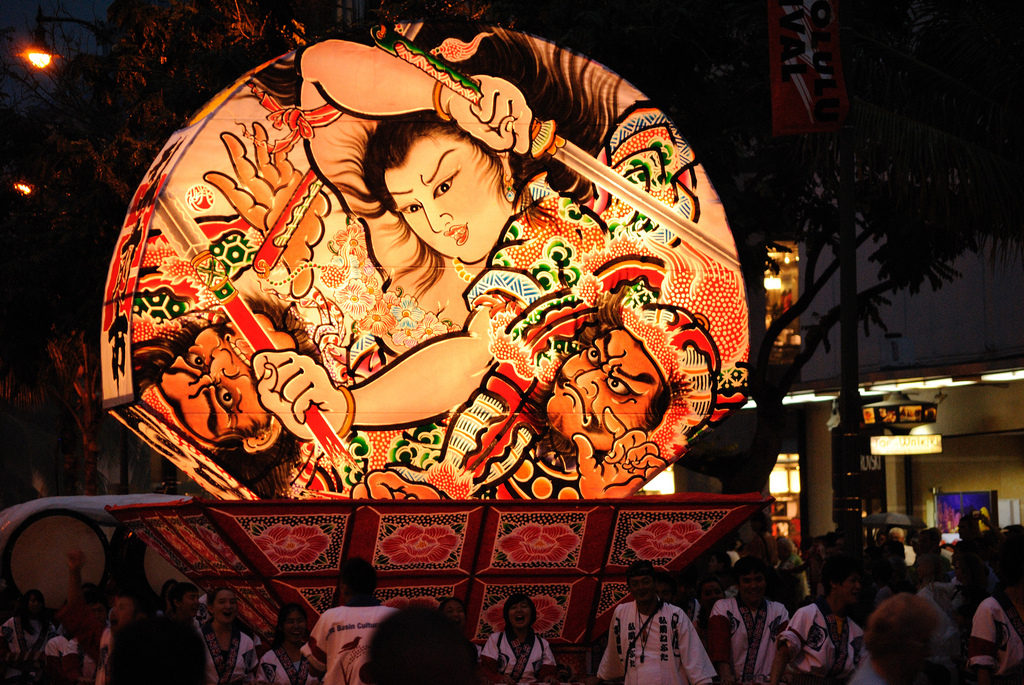 Neputa. Pic by Daniel Ramirez licensed under CC.
Neputa. Pic by Daniel Ramirez licensed under CC.
Neputa Mura is an exhibition space dedicated to Hirosaki’s world-renowned fan-shaped floats that depict kabuki scenes and are lit from within. The floats are paraded through the city in early August each year. At Neputa Mura, you can learn all about this tradition, as well as the other cultural talking points of Hirosaki.
Summer and spring are not the only seasons that are marked by special celebrations in Hirosaki – if you happen to be here in winter, you can enjoy the Hirosaki Castle Snow Lantern Festival (in early February), which features over 200 lanterns and 300 miniature igloos. Fall is fun too, thanks to the abundance of colorful autumn foliage.
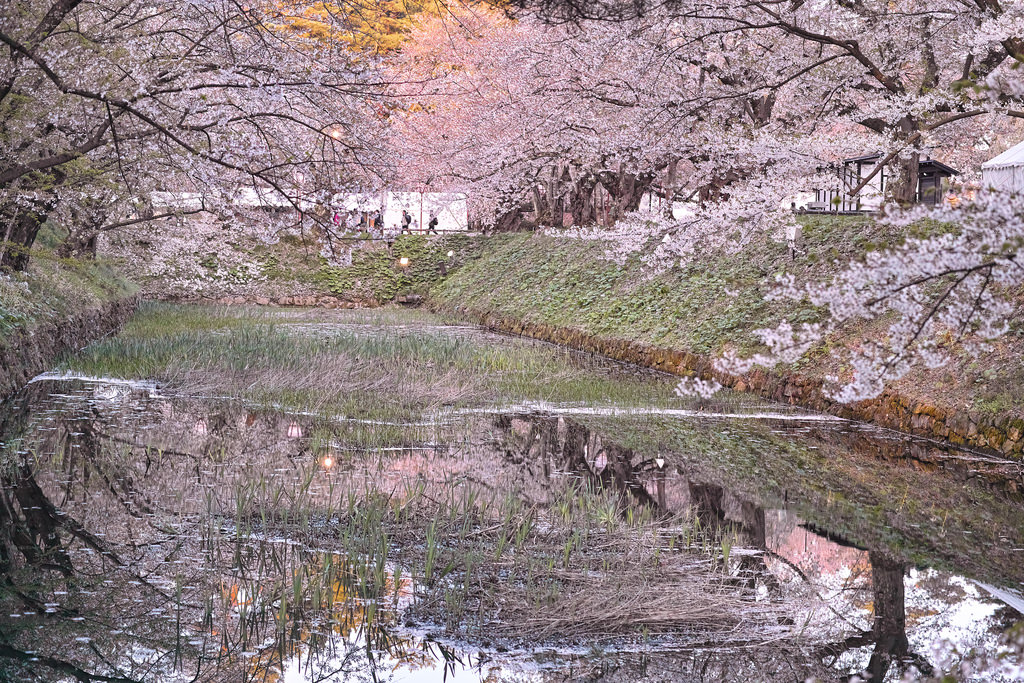 Hirosaki Cherry Blossoms. Pic by Daisuke K. licensed under CC.
Hirosaki Cherry Blossoms. Pic by Daisuke K. licensed under CC.
When you’re in the mood for dinner, Rankatei, just near Hirosaki Station, does really good ramen at reasonable prices – and with a flavorful local twist. There’s not much to do after dark in Hirosaki, so once you’ve eaten, head back to your accommodation for some well-deserved RnR.
Day Five: Shirakami Sanchi
While the UNESCO World Heritage Site of Shirakami Sanchi is only 18km to the west of Hirosaki as the crow flies, getting there means negotiating some very mountainous, windy roads, so the travel time may be up to 90 minutes. Note that there are no trains, so transport to the area will not be covered by your JR Pass.
You can catch a bus to Shirakami Sanchi via Konan Buses. Make an early start (there are only a few buses a day), getting on at either Stop 7 of the Hirosaki Bus Terminal, or Stop 6 of the bus station outside JR Hirosaki Station. Take the bus to the Aqua Green Village Anmon stop.
Travel time: Approximately 1.5 hours each way
Route: Bus from JR Hirosaki Station to Aqua Green Village Anmon
Cost: 2,470 yen (round trip)
Objective: Experience primeval beech forest
Shirakami Sanchi is a very rare stretch of virgin forest – a 130,000 hectare haven of Japanese beech trees that hides close to 90 species of bird, as well as Asian black bear and Japanese serow, among other wildlife. The forest, which features over 500 types of plants, is dotted with streams and waterfalls. The terrain of the region is best described as rugged – really rugged.
 Shirakami sanchi. Pic by C.K. Tse licensed under CC.
Shirakami sanchi. Pic by C.K. Tse licensed under CC.
In 1993, 169.7 square kilometers of the forest was designated as a World Heritage Area, and to get into that part, you’ll need special advance permission. However, no permit is required to explore the rest of the Shirakami Sanchi area, and there are a number of trails available to daytrippers from Hirosaki. We’ll be walking the Anmon Falls trail, a fairly easy route that takes us to a set of three beautiful waterfalls and back in under two hours.
Lunch can be had at Aqua Green Village Anmon at the start of the trail.The center also features a hot spring, which is a great way to soak sore legs while soaking up some amazing views from the open-air bath.
 Shirakami sanchi. Pic by C.K. Tse licensed under CC.
Shirakami sanchi. Pic by C.K. Tse licensed under CC.
There is an information hub called Shirakami-Sanchi Village Center where you can get insights into the geography and history of the region, but this is quite a distance from Aqua Green Village Anmon and best accessed by car or stopping off on the bus. However, the English-language Shirakami Sanchi website has useful information for visitors.
The best times of year to visit Shirakami Sanchi are late spring and early summer, when the meltwaters feed the streams and the beeches put out new buds. Fall is also picturesque. Winter, however, is not recommended, as many parts of the region are closed off. Whatever time of year you visit, you’ll need to dress warmly.
When you’ve immersed yourself in the beauty of Shirakami Sanchi for the day, make your way back to Hirosaki for dinner and preparations for Day Six.
Day Six: Hirosaki to Hakodate
Travel time: Approximately 2 hours 30 minutes, including waiting
Route: JR Ou Main Line to Shin-Aomori Station (30 to 40 minutes)
Change to the Shinkansen bound for Shin-Hakodate-Hokuto (1 hour 5 minutes)
Change to the JR Hakodate Line for Hakodate (25 minutes)
Regular cost: 8,580 yen
Objective: See an historic port and enjoy stunning views
 A speedy Shinkansen stopped at Shin-Aomori Station.
A speedy Shinkansen stopped at Shin-Aomori Station.
Today we’re heading to the southern tip of Hokkaido. Hakodate is the region’s third-largest city, and is known for its busy harbor, early foreign influence, and fresh seafood. It has a lot to offer in the way of vistas, dining and history, and a day and a half is ample time to get a taste of all of these features.
When you arrive, consider checking in to either Hakodate Kokusai Hotel, an excellent hotel that’s a short walk from JR Hakodate Station, or Pension Jokura, a cosy little spot that’s just down the road from Hakodate’s famous red brick warehouses (more on them below).
 View over Hakodate. Pic by Hiroaki licensed under CC.
View over Hakodate. Pic by Hiroaki licensed under CC.
To begin, we’ll be making our way to the summit of Mount Hakodate to get a good look at the scenic city. The 334m mountain can be ascended by foot, bus or ropeway – the latter is by far the most fun and convenient option. To get to the Hakodateyama Ropeway, you can take the Hakodate Tramway from Hakodate Station to the Jujigai stop (five minutes) and then walk to the base (10 minutes). The sight from the top of the mountain is one of Japan’s top three night views (the others being Mount Inasa in Nagasaki and Mount Rokko in Kobe), so if you’re moved by the daytime scene, you can return after dark – or do the day’s activities in reverse order.
 Red brick warehouses. Pic by chinnian licensed under CC.
Red brick warehouses. Pic by chinnian licensed under CC.
A much-loved sight in Hakodate is a row of red brick warehouses on the water’s edge, and this is our next destination, as it’s just five minutes away from the Jujigai tram stop. Hakodate’s port opened in 1859 as one of Japan’s first international trading centers, and the Kanemori Red Brick Warehouses, developed in 1887, facilitated much of the commerce that ensued. Today, the warehouses are home to a shopping complex that includes several patisseries; while you’re wandering around, try a bite-sized cheesecake from one of them – it’s a local speciality. Lunch can be found at any of the number of restaurants in the complex, too.
 Goryokaku. Pic by Miki Yoshihito licensed under CC.
Goryokaku. Pic by Miki Yoshihito licensed under CC.
From there, it’s back onto the tram in the direction of Fort Goryokaku – a star-shaped, Western-style fortress that was, ironically, built to defend the city from Western imperialist threats during the last years of the Edo period. Today, it’s a public park that features over 1000 cherry trees and a 107m observation tower. The view from the top is unique in Japan. In the center of the grounds, you’ll find the Former Magistrate Office, the building from which the shogunate once oversaw Hokkaido.
 Magistrate’s office Hakodate.
Magistrate’s office Hakodate.
If you’re in the mood for an early dinner, the nearby Ajitaka Ramen offers local-style noodles at reasonable prices. There’s no need to rush back to your hotel – the bay area is lit up at night, making for atmospheric evening strolls.
Day Seven: Hakodate to Tokyo
Today is the straight shot back to Tokyo. To get the best value out of your JR Pass, you should try to leave as late as possible, but be careful – the Shin-Hakodate-Hokuto to Tokyo route is one of the most infrequently travelled on the Shinkansen, so trains for Tokyo may leave only once an hour or less. The last train of the day for Tokyo (at the time of writing) leaves at 6:36pm each day.
Travel time: Approximately 4 hours 50 minutes
Route: JR Hakodate Line from Hakodate to Shin-Hakodate-Hokuto (25 minutes)
Change to the Shinkansen bound for Tokyo (4 hours 20 minutes)
Regular cost: 23,250 yen
Objective: See some more of Hakodate, and then get back to Tokyo
A fun way to start the day is by getting up early and grabbing a seafood breakfast at the Hakodate Morning Market (it’s open from 5am, or an hour later in winter), which is close to JR Hakodate Station. This is where locals come to source the best fish and other fresh produce. After that, a five-minute walk will take you to a moored ex-ferry, the Mashu Maru Memorial Ship, which used to run between Hokkaido and Aomori. It’s a floating museum that offers a surprisingly interesting window into the rail history of the region.
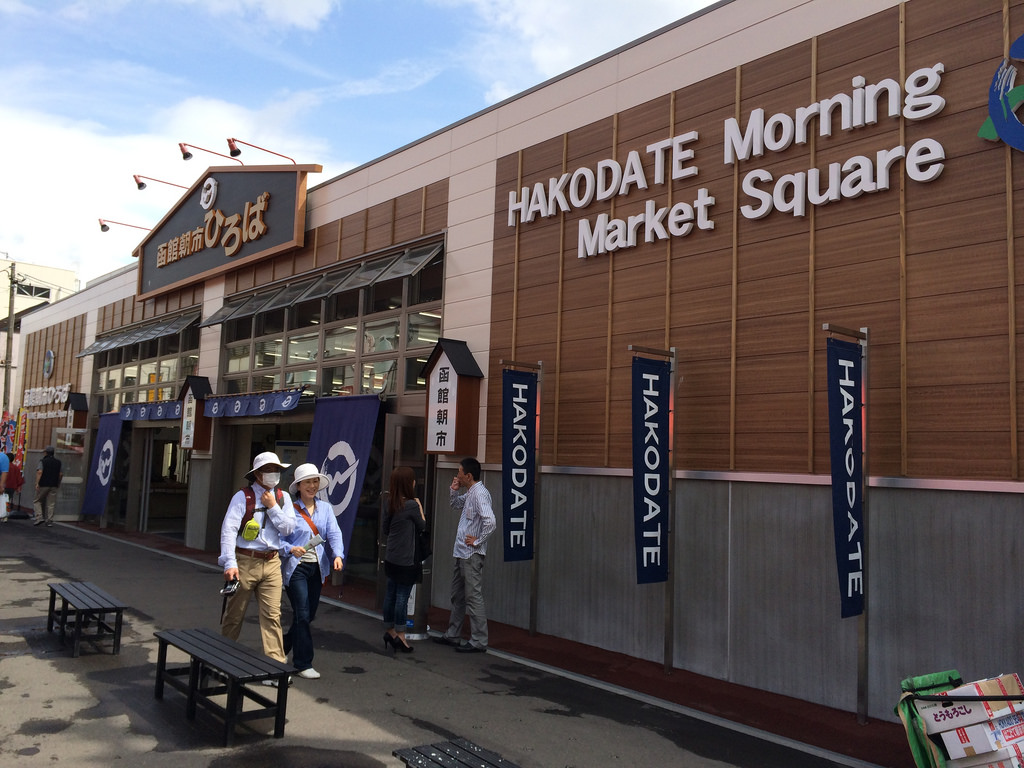 Hakodate morning market. Pic by Brian… licensed under CC.
Hakodate morning market. Pic by Brian… licensed under CC.
Another port of call today should be the Hakodate City Museum of Northern Peoples, which can be accessed by hopping onto a tram and alighting at the Suehirocho stop. Here, you can learn about the history and culture of the indigenous Ainu people.
From there, you could board the Hakodate Tramway once again, this time riding it 40 minutes to Yunokawa Onsen – a hot spring resort that Japanese people have been visiting for centuries. While you’re there, it’s worth making a turn past a Trappistine convent that was established in 1898 by French nuns, as well as strolling around the nearby park and botanical garden.
 Lake Oonuma. Pic by othree licensed under CC.
Lake Oonuma. Pic by othree licensed under CC.
Another way to spend the day is to head for Oonuma (it’s best to go right after breakfast), a wonderful area about 30 minutes north of Hakodate. Reminiscent of Matsushima, two lakes (the large Oonuma and smaller Konuma) are dotted with tiny islands, many of which you can access via quaint curved bridges. To get to Oonuma, you can take an express from JR Hakodate Station to Onumakoen Station. The regular cost is 1,680 yen each way, but your JR Pass will cover it.
Alternate Day Seven: Sapporo and onwards
By the time you’re in Hakodate, you’re already a long way north, so why not continue on to the region’s major city – Sapporo? But my JR Pass only goes for 7 days, you may argue. This is true. Another truth is that the Sapporo to Tokyo air route is one of Japan’s busiest, with lots of low-cost carrier airlines offering fares as low as 5,000 yen one way. So instead of scrambling back to Tokyo, you could take a JR Hokkaido train up from Hakodate to the northern island’s capital. Another point of interest (especially to onsen lovers) in Hokkaido is the area of Noboribetsu.
 Noboribetsu. Pic by Carey.
Noboribetsu. Pic by Carey.
Seasonal Notes
Northern Japan (Aomori in particular) is famous for being one of the snowiest places on the planet. For this reason, the attractions between warm months and cold months may be quite different, and getting around may take considerably longer than you anticipate. Don’t let the prospect of winter put you off, though – it’s beautiful in its own way!
Buses and Trams
Unless specified, bus and tram fares are not covered by the JR Pass.
Categorised in:
This post was written by Japan Rail Tickets
